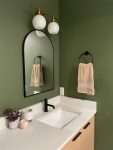Guide to Mixing Metals

Mixing metals used to be against the rules. But nowadays, we’ll see two, and sometimes three, different metals within a single room. When done well, this can add interest, harmony and movement to a space. When done wrong, it can feel unsettling and a bit cringy. So how do you know you’re mixing metals the right way? Here are some tips:
Decide on your dominant metal first
- Which one do you want to ground the space? This is typically the one that’s on the majority of your kitchen cabinets or your bathroom vanity.
Once you decide on your dominant metal, choose another one that compliments it, not one that battles it.
- You want one group of hardware that dominates, and another that’s simply an accent piece. You want to create enough movement without it being off-putting. In other words, you want the eyes to move smoothly from the brass cabinet knobs to the black sconce above the sink. Enough contrast to bring interest to the space without it being overwhelming.
Try not to go 50/50
- Don’t have half chrome and half brushed gold in a single space. Contrast is good when it’s subtle, not competitive. Again, one metal needs to dominate for the space to feel complete.
Ensure the finish/sheen is different from one another
- When you mix metals, ensure you don’t have a polished metal with another polished metal. Or a brushed metal with another brushed metal.
- For example, you can mix polished brass with black or stainless steel, but not chrome. You can mix chrome with brushed gold or black, but not polished brass. Think: One shiny, one brushed.
What about the third metal?
If you decide to get bold and throw a 3rd metal in the mix, you have a couple options:
- Make black the 3rd metal.
- Black goes with everything. Yes, even bronze. So if you have already chosen a polished brass and a stainless steel, make black the final metal.
- Don’t do metal – Go with a different material
- Choose knobs that are wooden, leather or rattan. Go with knobs or a light fixture that have a unique, textured material. Options like these always add character to a room.
What about appliances?
- Appliances don’t apply with this rule because they are so second-nature. Typically, one won’t notice if there is a stainless steel appliance next to a brushed hardware. Appliances only stand out negatively if they are placed with the wrong cabinet paint color. And even then, there aren’t many paint colors that clash with many appliances. The main key here is simply contrast.
Mix metals with these tips in mind, and you’re sure to have a beautifully balanced space. If you still need help, message me, or your designer friend, for some insight!